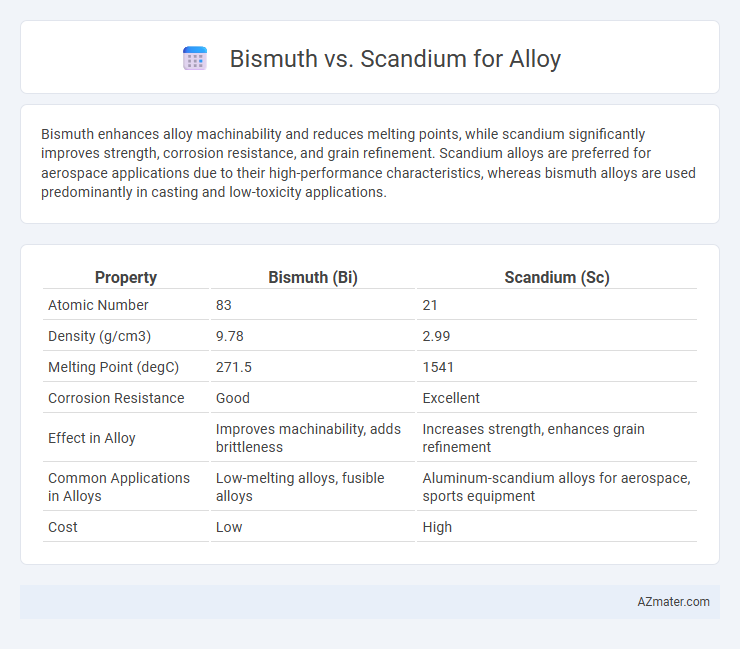Bismuth enhances alloy machinability and reduces melting points, while scandium significantly improves strength, corrosion resistance, and grain refinement. Scandium alloys are preferred for aerospace applications due to their high-performance characteristics, whereas bismuth alloys are used predominantly in casting and low-toxicity applications.
Table of Comparison
| Property | Bismuth (Bi) | Scandium (Sc) |
|---|---|---|
| Atomic Number | 83 | 21 |
| Density (g/cm3) | 9.78 | 2.99 |
| Melting Point (degC) | 271.5 | 1541 |
| Corrosion Resistance | Good | Excellent |
| Effect in Alloy | Improves machinability, adds brittleness | Increases strength, enhances grain refinement |
| Common Applications in Alloys | Low-melting alloys, fusible alloys | Aluminum-scandium alloys for aerospace, sports equipment |
| Cost | Low | High |
Introduction to Bismuth and Scandium Alloys
Bismuth alloys offer excellent machinability and low toxicity, making them ideal for applications requiring environmentally safe materials with reduced thermal expansion. Scandium alloys significantly enhance the strength and corrosion resistance of aluminum, widely used in aerospace and sporting goods due to their lightweight yet durable properties. Understanding the distinct characteristics of bismuth and scandium alloys aids in selecting the optimal material for specific industrial and engineering applications.
Chemical and Physical Properties Comparison
Bismuth, with an atomic number of 83 and a density of 9.78 g/cm3, exhibits low thermal conductivity and high electrical resistance, making it ideal for low-melting alloys and specialized casting. Scandium, atomic number 21 and density 2.99 g/cm3, offers high strength-to-weight ratios, excellent corrosion resistance, and enhanced grain refinement in aluminum alloys due to its small atomic size and stable crystal structure. The contrasting chemical inertness of bismuth compared to the reactive metallic nature of scandium significantly influences their roles in alloy applications, where bismuth enhances machinability and scandium improves mechanical performance.
Alloy Formation Processes
Bismuth and scandium exhibit distinct behaviors in alloy formation processes due to their differing atomic structures and melting points. Bismuth, with its low melting point of 271degC and tendency to segregate, promotes easy melting and phase separation in alloys, crucial for solders and fusible alloys. Scandium, characterized by a higher melting point of 1541degC and strong grain refinement properties, enhances alloy strength and corrosion resistance by forming stable intermetallic compounds, especially in aluminum-based alloys.
Mechanical Strength and Durability
Scandium alloys exhibit superior mechanical strength and durability compared to bismuth alloys, with scandium enhancing grain refinement and improving tensile strength and fatigue resistance. Bismuth, being a heavy post-transition metal, generally reduces alloy hardness and mechanical robustness but offers benefits in low melting point and machinability. Scandium's addition to aluminum alloys significantly increases corrosion resistance and long-term structural integrity, making it preferable for high-performance aerospace and automotive applications.
Corrosion Resistance and Longevity
Bismuth alloys exhibit moderate corrosion resistance but tend to degrade faster in harsh environments compared to scandium alloys. Scandium significantly enhances aluminum-based alloys by improving corrosion resistance and promoting longer lifespan due to its ability to form stable oxide layers. The superior longevity of scandium-containing alloys makes them ideal for aerospace and marine applications where durability against corrosion is crucial.
Weight and Density Differences
Bismuth has a density of approximately 9.78 g/cm3, significantly higher than scandium's density of about 2.98 g/cm3, making scandium alloys notably lighter. The substantial weight difference influences alloy applications, where scandium's low density benefits aerospace and sports equipment by reducing overall mass while maintaining strength. Bismuth's higher density alloys suit applications requiring added weight and stability, highlighting the importance of density in material selection.
Applications in Industry and Technology
Bismuth alloys are widely used in applications requiring low melting points and non-toxic materials, such as automotive fuses, fire detection devices, and medical casting. Scandium enhances aluminum alloys by significantly increasing strength and corrosion resistance, making these alloys ideal for aerospace components, sports equipment, and military applications. Industrial use of scandium-aluminum alloys provides lightweight, high-performance materials critical for advanced technology manufacturing.
Environmental Impact and Sustainability
Bismuth exhibits low toxicity and excellent recyclability, making it an environmentally friendly choice for alloys compared to heavy metals, while its low melting point reduces energy consumption during processing. Scandium alloys offer exceptional strength and lightweight properties, enhancing fuel efficiency in aerospace applications, yet their rarity and energy-intensive extraction process pose sustainability challenges. Utilizing bismuth in alloys supports green manufacturing practices, whereas scandium's environmental footprint demands careful resource management to ensure sustainable use.
Cost Analysis and Market Availability
Bismuth is significantly more abundant and cost-effective than scandium, with bismuth priced around $8 per kilogram compared to scandium's high market cost exceeding $4,000 per kilogram due to its rarity and complex extraction process. Scandium's limited global production, primarily concentrated in a few countries like China and Russia, restricts its availability and drives prices higher, while bismuth benefits from stable supply chains tied to lead and copper mining. Cost analysis strongly favors bismuth for alloy manufacturing where affordability and consistent supply are critical, whereas scandium's expensive and scarce nature limits its use to high-performance, specialized aerospace and sporting applications.
Future Trends in Alloy Innovations
Bismuth and scandium alloys are driving future trends in lightweight and high-performance materials, with scandium offering exceptional strength-to-weight ratios and enhanced weldability for aerospace and automotive applications. Bismuth's unique non-toxic and low-melting properties enable innovative uses in lead-free solders and eco-friendly alloys, aligning with increasing environmental regulations. Emerging research focuses on combining bismuth's sustainability with scandium's mechanical advantages to develop next-generation multifunctional alloys for advanced industry needs.

Infographic: Bismuth vs Scandium for Alloy
 azmater.com
azmater.com